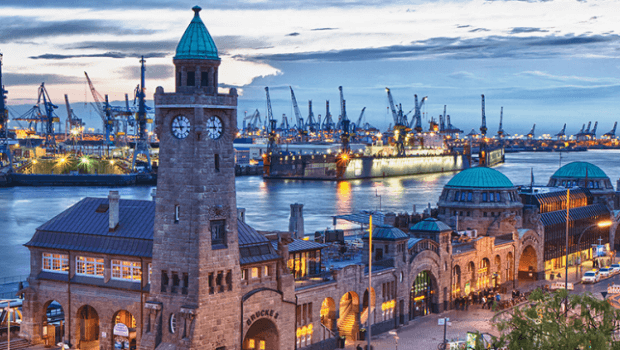
Hamburg: A city that has rebuilt itself again and again
The city that hamburgers are named after has more canals than the combined number of bridges in Amsterdam and Venice. Situated on the river Elbe, it is a significant aerospace center of the world, third after Seattle (USA) and Toulouse (France). It has a glorious mercantile background that every citizen of the city is proud of, which was supported and fueled by one of the country’s biggest port, counted among the busiest in Europe. It is also called “Free and Haematic” city and is one of Germany’s 16 Federal States or Bundeslander. It has been possibly the most independent of all German states for a long time now.
Even as an imperial city, it was under the sovereignty of only the emperor.
Location
Located in the south of Jutland Peninsula, Hamburg has its South surrounded by Europe and North surrounded by Scandinavia. On its west lies the North Sea and on its North East lies the Baltic Sea.
Weather
Hamburg is surrounded by ocean, so the Atlantic Ocean’s marine air controls its climate. In the recent past, the winters have become less severe, with it snowing every few days. The chilliest months are December to February and July, and August are the warmest months.
History
Treva was the first name reported by Claudius Ptolemy for the city. Later, Emperor Charlemagne ordered the construction of a castle in AD 808 as defense strategy from Slavic incursion, lying between the River Elbe and River Alster, by the name of Hamburg. Fredrick “Barbarossa”, in 1189, declared Hamburg an Imperial free city, by imperial charter. The city had been captured and destroyed many times before this. Hanseatic League of trading Leagues came into being with the beginning of Hamburg’s trade with Lubeck in 1241.
1860 was a landmark year for Hamburg as it marked the adoption of a democratic constitution that promoted the election of the Senate, among many other empowering laws. When the Second World War broke out, Hamburg was a Gau and suffered several air raids that wrecked the city and its harbor.
The second world war brought with it destruction and mass murders, the likes of which had never before been seen. Hitler may have been against Jews, but when the air raids by Royal Air Force (RAC) began, it did not matter who you were; you would have to die like an insignificant thing if the basements in your neighborhood were not deep enough to protect you. But that was if you were not already dying by the minute in the many concentration camps.
23rd July 1943 was a black day in the history of Hamburg when innumerable citizens and property (mainly boroughs, that were always densely populated) were killed and destroyed in RAF bombings that had created a firestorm that spread and destroyed wildly. Approximately 42,600 civilians were killed in these raids and over a million had to be evacuated. Jews were present in the greatest number in Hamburg in Germany, and 42,900 of them were killed through bombings of the Royal Air Force and epidemics in Neuengamme concentration camp.
Hamburg Commonwealth War Graves Commission Cemetery in Ohlsdorf is where you can visit these brave hearts who perished as a part of the cruelest conspiracy and heart-wrenching dictatorship that the world has ever known.
1960-62 saw the launch of The Beatles, the pride of the city, as they played in several parts of the city, later becoming the legends that they are today.
The City
Hamburg is counted among the likes of London in terms of its wealth and is nicknamed ‘Gateway to the world’ due to its gigantic port, which is the second largest in the whole of Europe. The architecture reflects its mercantile past, which is the reason behind its wealth. Predictably, it is the home of one of the most ancient banks in the world, the Berenberg Bank. The Parliament and Senate are housed in the majestic Town Hall.
Ironically, the people are frank, and yet, they are cautious. They may appear vary, but are very candid once they begin to know you. If you like to shop, you must visit the Monckebergstrabe located in the center of the city. And the Fischmarkt is worth a visit. Every Sunday, the fish auction hall is brought to life by several performances by artists, and people come to loose themselves in all genres of music, like Jazz, country, and so on.
Traveling the City
Hamburg is an advanced, metropolitan city. The Public transport network is reliable, well organized and stretches throughout the city. Buses run through the day and at night they have Nachtbus, or night bus, which connects Hamburg to its surroundings. The drivers of these transports and all other ticket offices also sell the Hamburg card, which can be used for traveling through all the public transports, visit museums among other things.
The residents can be see driving bicycles, especially in the warmer months. You can also use a bicycle when you are in the city since Hamburg offers bicycles on hire. But, they are forbidden on the subways before 9 in the morning and between 4 to 6 in the evening (unless they are folding bicycles).
Why visit
The city has three islands, Neuwerk, Scharhorn, and Nigehorn, that are great tourist destinations and waiting to be explored. The city has various spectacular bridges, and although churches constitute its chief landscapes, some innumerable other festivals and monuments boast of the city’s long, rich history. The town hall is a lavishly embellished neo-renaissance monument completed in 1897. The city center stands around what can be called the wonders of human intelligence, lake Binnealster and lake Aubenalster, formed by the damning of River Alster.
Around this river is held the Alstervergnugen festival. Northern Germany’s biggest festival, Hamburger DOM, is held a year thrice, during Summer, spring, and winter and lasts for a month each time. The fairground’s streets are lined up to 3.3 km on both sides, comprising of stalls and rides. St. Michael’s Church holds the bikers’ service, which is popular among bikers from far and near. Hamburg also has a number of museums. It also hosts the Gay Pride Hamburg Pride Festival, the Filmfest Hamburg, and the Hamburg marathon, which ranks second after Berlin.
Apart from these, you are also welcome to join the many neighborhood and street parties and enjoy the Franzbrotchen, for those with a sweet tooth. Also, Hamburg is among Germany’s principal media hubs. This makes it one of the most visited places in the region.
Major attractions
- Miniature Wonderland: Housed by the legendary Speicherstadt district, this is the largest of its kind model railway. Although until last year (2015) it had 10,400 meters of railway track, the building is still undergoing construction, which is expected to be completed by 2020, covering an area of 24,757 sq. ft. The first part of it began to be constructed in December 2001.
- Planten un Blomen: A rare one of its kind, this public park is extremely famous even among the citizens due to its many attractions. Not only does it contain the old botanical garden, but there are also frequent water- light concerts, concerts and public theater happening all year round in the park. There is no entry fee to the park.
- Michael’s Church: Out of its five Lutheran churches, this church is the most famous and largest in Hamburg, and is a dedication to Archangel Michael. Nine cities have constructed a replica of this church.
- Tierpark Hagenbeck: Although it is sometimes called a zoo, you can rest assured that the animals are not caged. Moats surround them. Founded in 1907 by Carl Hagenbeck Jr as a collecting ground for his father, Carl Hagenbeck Sr, who began his collection of exotic animals in 1863, the port helped his endeavors and it proved much more successful than his fish shop.
- Museum fur Kunst und Gewerbe: Inspired by the Victoria and Albert Museum in London, Kunstgewerbemuseum in Berlin and Vienna’s Museum fur Angewandte Kunst, 1874 saw the foundation of this decorative, fine and applied arts museum. The Art Nouveau, Keyboard instruments, representations of the late 17th and early 18thcentury porcelain, are all exhibited among many other awe-inspiring exhibits.
- Hamburg Rathaus: The Hanseatic and free Hamburg City’s Town Hall, the government of Hamburg’s seat, located near the central station and Binnenlaster lake, are all major tourist hotspots that attract tourists all round the year. Architecturally, neo-renaissance, it is a symbol of German empire’s formation that was marked by the defeat of France in the Franco-German war. It has six more rooms than the Buckingham Palace, a total of 647, and covers 58,15 sq. ft. Completed in 1897, it continues to house the First Mayor of Hamburg’s office and Hamburg’s Senate and parliament’s meeting rooms.
Beatles-Platz: It is exactly what you think it is by its name. To honor the importance of Hamburg for The Beatles, the plaza was initiated by Oldie 95, Hamburg’s radio station. The metal statues of the band members surround this building that was completed in 2006, just before the Football World Cup.
What Else is Around
- Schwerin
- Lubeck
- Ratzeburg
- Glucksburg
- Helgoland
- Westerland
- Wismar
Hamburg is the perfect place to visit if you’re visiting Germany anytime soon. With so many tourists’ hotspots and amazing places to see around, one couldn’t ask for more. Plan a holiday vacation with your family and spend some quality time, exploring this beautiful German city. You will return with memories that you’ll cherish lifelong. So, go ahead and visit Hamburg – you won’t regret it, we promise!
